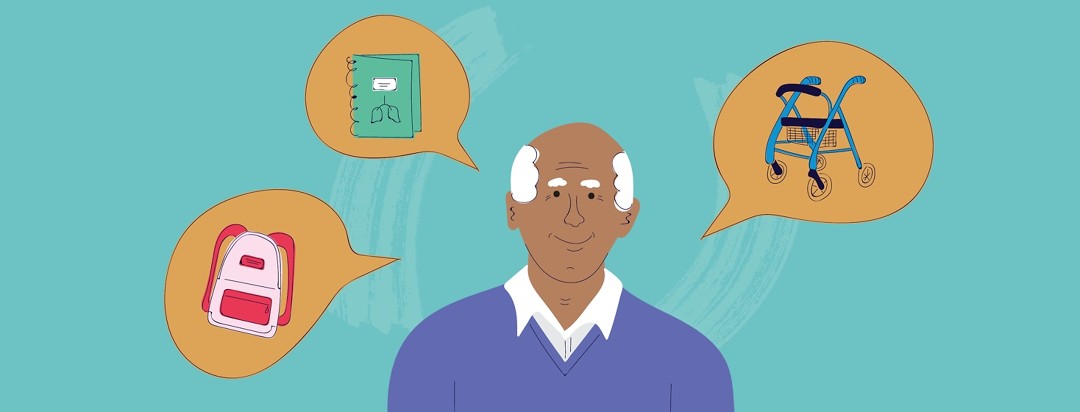Ask the Advocates: Assistive Devices
We asked our health leader team which assistive devices or tools work best for their chronic obstructive pulmonary disease (COPD) and lifestyle. Check out their answers below, and comment with your own answers!
Kevin
I’m not sure if some of these tools/devices qualify, but one device that has been particularly helpful to me is the run-of-the-mill, everyday grocery shopping cart. Whether I’ve got my backpack strapped on with my “D” oxygen tank blazing away or not, I find it helpful to lean onto the handle of a grocery shopping cart/wagon when I’m in the store.
I’m not talking about throwing my whole body onto the handlebar as I’ve seen some folks do (and I cannot figure out why and how they do it). Rather, just shifting as much weight as I can onto my arms and then leaning.
Now, granted, I’m not at many of these places to do major shopping (like the week’s groceries for the family). And it may look a bit odd to see someone like me pushing the cart with a single quart of milk in it. But when I am at a Home Depot, Walmart, or some kind of other large superstore, inevitably what I need is at the farthest end of the mammoth building. And I’m going to have to walk there to get it!
Speaking of backpacks, I find the regular backpacks from camping stores like Eddie Bauer, LL Bean, Cabelas, and Lands’ End much better than those that are supplied by medical warehouses. Here's why:
- They have more room.
- Their zippers are more pliable and seem to last much longer than those of medical brands.
- They have extra pockets for valve keys, cannulas, and hoses.
Read Kevin's bio here!
Michelle
My rollator is my absolute favorite assistive device. It is a Hugo Elite with:
- A padded seat
- Ergonomic handles
- Extra large wheels
- A storage bag under the seat and another in the curved backrest
- The ability to handle up to 250 pounds
- A stunning cobalt blue color
All it is missing are racing stripes and fuzzy dice. It's lightweight, so I can pack it in my van and handle it myself. It's comfortable, and when I'm in the middle of an activity like grocery shopping, it's an ever-present resting place.
Sometimes my legs give out when I'm walking, and with this walker, I can sit down immediately or I can hold myself up by grasping the handles. It helps me steady and balance myself. It can go almost anywhere. Because it's a rolling walker, it moves smoothly without tripping me up.
You can get a rollator by prescription, and most insurance plans will cover it. Another option is to purchase one online. Some drug stores sell walkers. Some hospitals have associated thrift stores, and sometimes you can find walkers and wheelchairs there. There are also some thrift stores that are dedicated to helping the disabled, and they usually carry walkers or wheelchairs at a very low price.
Read Michelle's bio here!
Karen
One thing that made life easier for my mom to get up and down was to get an extra firm foam cushion to use in her favorite chair. We found an upholstery store that cut a square exactly the same size as her chair. We folded a complementary colored fabric around it. After lifting the regular cushion out, we put the firmer foam down and then simply put the original on top. It elevated her about 4 inches.
The cushion helped in a couple of ways. First, it didn't allow her to sink so far down. Second, she was able to stand up more easily without as much effort.
Read Karen's bio here!
Theresa
One tool I use on a daily basis is what I call my “Lung Journal.” You might have heard it called a COPD diary as well. Every day I write how my breathing was, if I had any issues, what the weather was like, and any other triggers. I also write whether/how many times I needed to use my rescue inhaler or nebulizer, and any other notes I want to add.
Keeping a daily (or even weekly, if daily is too much for you) journal keeps it all together in one place. So when you have appointments with your pulmonologist or primary care doctor, you can bring it with you to refer to. I also have a section where I write down any questions I have for my doctor or any specific things I want to address at that appointment.
I am glad I write things down because when I’m in the room with the doctor, 9 times out of 10 I will forget something I really wanted to talk about. My doctor is always impressed when I bring the book in with me!
Read Theresa's bio here!
John
There are some devices that can assist people living with COPD. One I am familiar with, as a respiratory therapist, is an acapella.
This is a lightweight device you can hold in one hand. It has a mouthpiece that you bring up to your mouth and put your lips around. As you blow into it, you can feel vibrations inside your chest. These vibrations can help knock thick mucus from your airways so you can more easily cough it up.
So, these neat little devices can help improve your cough. A lot of times, I give them to patients in the hospital setting. I do this especially when they feel like they have stuff in their throats but can’t get it up. Acapellas can help with this.
Read John's bio here!
What tools or devices have you found helpful for your COPD? Comment below!

Join the conversation